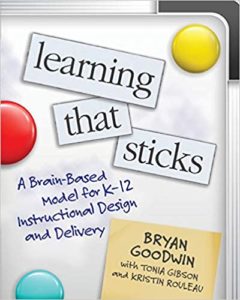A Brain-Based Model for Sticky Learning
Learning That Sticks: A Brain-Based Model for K-12 Instructional Design and Delivery
By Bryan Goodwin with Tonia Gibson and Kristin Rouleau
(ASCD, McREL, 2020 – Learn more)

Learning That Sticks breaks learning down into a 6-phase process (a mental model) based on current brain/learning research, in an effort to help educators be sure they address each phase and thereby increase the learning of our students.

Not surprisingly, “we purge 90 percent of what we learn within 30 days – with most of that forgetting happening within the first few hours.”
Therefore, they argue, it is important for us to understand how to get our bits of curriculum to be processed by the brain and, more importantly, to be retained in such a fashion that students are able to retrieve that information and apply it to solve novel problems.
Understanding the mental process
The model’s six phases are grouped into 3 categories:
The Phase of Learning – becoming interested and committing to learning;
The Phase of Working Memory – being focused on learning and making sense of learning; and
The Phase of Long Term Memory – practicing new learning and extending, applying and finding meaning in new learning (making mental models and continually refining them).
Following an introductory chapter (you can read it here), each of the 6 phases have their own chapter. Then the book is rounded out with a final chapter that addresses how to use what you have learned and the included strategies to increase your professional practice through various implementation pathways. The chapter finishes with a frequently asked question section.
This book grows out of McREL International’s long history of research into “what works” and ties back to many of the strategies in the landmark Classroom Instruction that Works.(2001; 2012). It also contains data from numerous meta-analyses. The authors provide several tables which clearly outline guiding questions and activities for each of the phases of learning, and one that specifically ties the phases of learning to the strategies in Classroom Instruction That Works.
Blending the book’s phases with current brain research
While the descriptions of how the operations of the brain tie to the phases and the strategies are more general (which some might appreciate), the authors do base their model on current brain research and numerous meta-analyses of educational research findings.
This is a useful model of learning that includes the key components of recent learning science (interleaving, spaced practice, retrieval practice, etc.) and is worth a read.
Dr. Laura Von Staden is currently a Middle School Gifted Math and Science teacher in Tampa, Florida. She serves on numerous committees in her school district, works closely with the local university, and writes curriculum. She is also a professional development consultant, and previously served as an Exceptional Student Education Specialist, and as a mentor.


































